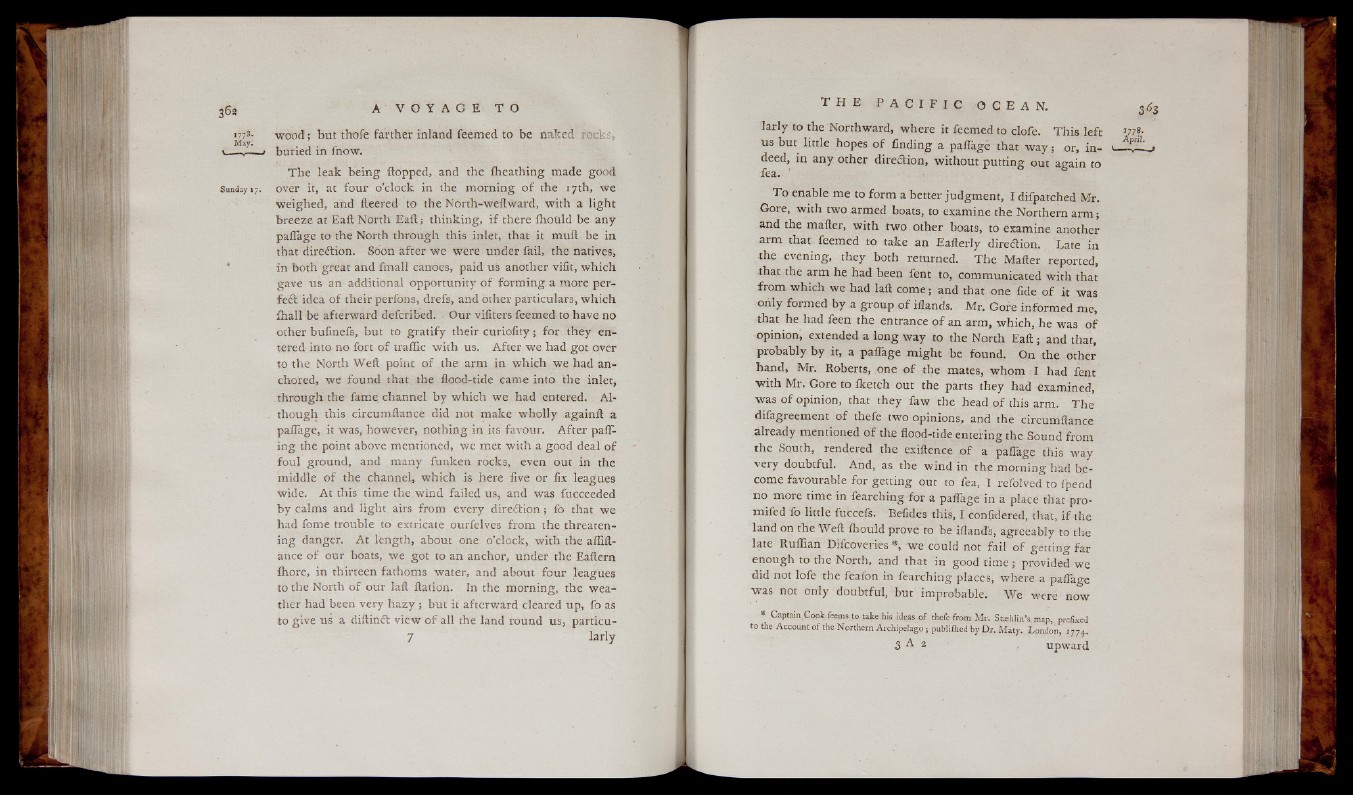
■wood; but thofe farther inland feemed to be naked rocks,
buried in fnow.
T h e leak b e in g flopped, and the fheathing made good
over it, at four o’clock in the morning o f the 17 th, w e
weighed, and fleered to the North-weft Ward, with a ligh t
breeze at Eaft North E a ft; thin kin g, i f there ihould be any
paflage to the North through this inlet, that it muft be in
that direction. Soon after we were under fail, the natives,
in both great and fmall canoes, paid us another vifit, w h ich
gave us an additional opportunity o f formin g a more per-
fedt idea o f their perfons, drefs, and other particulars, w hich
fhall be afterward defcribed. Our vifiters feemed to have no
other bufinefs, but to gra tify their cu r io iity ; fo r they entered
into no fort o f traffic w ith us. Afte r we had got over
to the North Weft point o f the arm in which we had anchored,
w e found that the flood-tide came into the inlet,
through the fame channel by w hich we had entered. Although
this circumftance did not make w h o lly againft a
paflage, it was, however, nothing in its favour. A fte r pairin
g the point above mentioned, we met w ith a good deal o f
fo u l ground, and many funken rocks, even out in the
middle o f the channel, which is here five or fix leagues
wide. At this time the wind failed us, and was fucceeded
b y calms and light airs from every direction ; fo that w e
had fome trouble to extricate ourfelves from the threatenin
g danger. At length, about one o’clock, with the aflift-
ance o f our boats, we got to an anchor, under the Eaftern
fhore, in thirteen fathoms water, and about fou r leagues
to the North o f our laft ftation. In the morning, the weather
had been very h a zy ; but it afterward cleared up, fo as
to give us a diftindt view o f all the land round us, particu-
7 la rly
la r ly to the Northward, where it feemed to clofe. This left w?-
us but little hopes o f finding a paflage that w a y ; or, in - -
deed, in any other direction, without putting out again to
Lea- 1
T o enable me to form a better judgment, I difpatched Mr.
Gore, w ith two armed boats, to examine the Northern a rm ;
and the mailer, w ith two other boats, to examine another
arm that feemed to take an Eafterly diredtion. Late in
the evening, they both returned. T h e Mailer reported,
that the arm he had been fent to, communicated with that
from which we had laft com e ; and that one fide o f i t was
only formed b y a group o f iilands. Mr. Gore informed me,
that he had feen the entrance o f an arm, which, he was o f
opinion, extended a long w a y to the North Eaft ; and that,
probably b y it, a paflage m igh t be found. On the other
hand, Mr. Roberts, one o f the mates, whom I had fent
w ith Mr. Gore to iketch out the parts they had examined,
was o f opinion, that they faw the head o f this arm. T he
difagreement o f thefe two opinions, and the circumftance
already mentioned o f the flood-tide entering the, Sound from
the South, rendered the exiftence o f a paflage this way
ve ry doubtful. And, as the wind in the morning had become
favourable for ge ttin g out to fea, I refolved to i'pend
no more time in fearching for a paflage in a place that pro-
mifed fo little fuccefs. Befides this, I confidered, that, i f the
land on the Weft ihould prove to be iilands, agreeably to the
late Ruffian Difcoveries *, we could not fa il o f getting far
enough to the North, and that in good t im e ; provided we
did not lofe the feafon in fearching places, where a paflage
was not only doubtful, but improbable. We were now
* Captain Cook feems to take his ideas o f thefe-from Mr. Stashiin’s.map, prefixed
to the Account o f the Northern Archipelago; publiihed by D r. Maty . L o n d o i, 1774.,
3 A 2 ■ upward